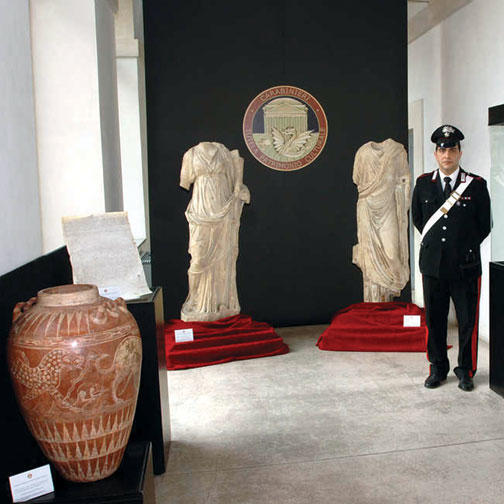Art museum returns more ancient artworks to Italy
For the second time since 2007, the Princeton University Art Museum has returned Greco-Roman antiquities to Italy amid concerns that the ancient artworks had been illegally excavated.
According to a Jan. 25 statement by the University, six items — some comprised of fragments — were returned in December. The University said the art museum undertook an internal analysis of items in its collections and then approached Italian authorities. A transfer agreement was signed in June 2011.
The items transferred from Princeton to Italy included a pair of statuettes of women playing musical instruments; a red jar, or pithos, decorated with white animals; and a black-glazed askos, used for pouring liquids. Also returned were three sets of fragments: of a vase, or calyx krater; an architectural relief; and architectural revetments used as a wall facing.
The University announcement stressed that the agreement with Italian authorities recognizes that legal title before the transfer rested with Princeton and that the objects were acquired by the University in good faith. Princeton declined to release any information relating to their acquisition or to provide identifying information that would allow the provenance to be tracked, citing a confidentiality clause in the agreement.
In 2010 it was reported widely that Italian police were investigating Michael Padgett, curator of ancient art at the Princeton University Art Museum, and former New York antiquities dealer Edoardo Almagià ’73, who the Italian authorities claimed were involved in “the illegal export and laundering” of ancient artifacts that then were accessioned into the art museum. Both men have denied wrongdoing, and the status of the investigation remains unclear.
Italian police announced the return of numerous objects from Princeton and other American institutions, including the Metropolitan Museum of Art, on Jan. 20, estimating the total value at $2.6 million. The Met returned vase fragments to Italy in December “to serve as evidence in the investigation and possible trial of Edoardo Almagià,” Elise Topalian, a spokeswoman for the Met, told PAW.
University spokesman Martin Mbugua would not say whether the objects returned in December had been sold or donated to the collection by Almagià. But according to Il Messaggero journalist Fabio Isman, the Carabinieri art police said at a press conference that the returned objects were associated with Almagià. Authorities released photographs of returned objects from various American museums and collections placed on public display in Rome; prominent in the photos is a red jar that appears identical to one given by Almagià to the art museum in 1999.
“There was no investigation of the University, and no allegations were ever brought against it,” Mbugua said. He also said that the art museum collections continue to include items donated by or purchased from Almagià. “There are no other antiquities being considered for return,” he said.
On his blog, Looting Matters, David Gill, a professor of archaeological heritage at University Campus Suffolk in the United Kingdom, criticized Princeton as among those museums that do not adhere to a policy of complete “transparency” regarding their returns of contested artifacts.
“Princeton values its integrity, but the silence of its museum, with its unwillingness to release details of the objects with their collecting histories, would seem to suggest that there is a deliberate lack of transparency,” Gill told PAW. “This is in marked contrast to the Dallas Museum of Art and the Museum of Fine Arts Boston, which have published online pieces associated with Almagià so that there can be proper public scrutiny.”
In response, James Steward, the director of the art museum, told PAW that “very few museums, if any, have in fact a policy of ‘complete transparency’ relative to acquisitions. Indeed, past agreements with donors, gallerists, and others may preclude such transparency. We continue to value these relationships, just as we do the public trust that is placed in our museum, and we seek to acquit ourselves of that trust while honoring the privacy of the individuals with whom we work.”
Steward added that the museum “is profoundly committed to honoring the integrity of cultural property and to stamping out illicit trade of all kinds in works of art, and now has among the most rigorous acquisitions and loan policies in the museum industry.”
In a 2007 agreement with Italy, the University returned eight works of art thought to have passed through the hands of dealer Giacomo Medici, now in prison for the sale of illegally excavated antiquities. In exchange, Princeton students were granted special access to archaeological digs in Italy. The Italian government also loaned several objects to the Princeton art museum, including a marble head of Apollo.












No responses yet